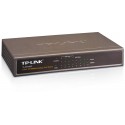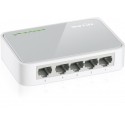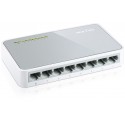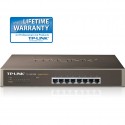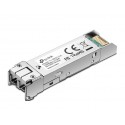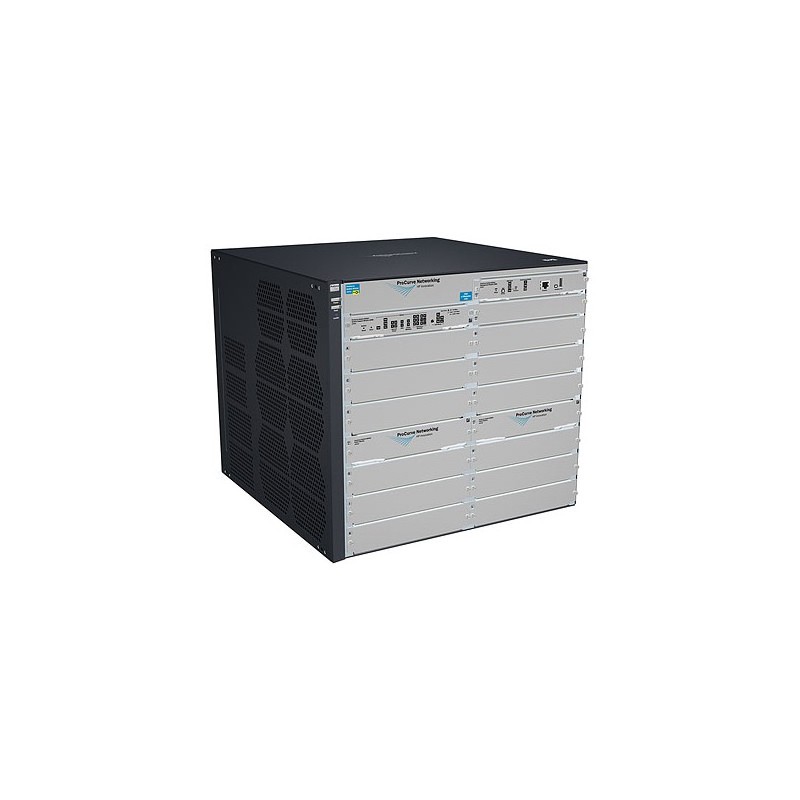
The HP 8200 zl Switch Series offers high performance, scalability, and a wide range of features in a high-availability platform that dramatically reduces complexity and provides reduced cost of ownership. As part of a unified wired and wireless network infrastructure solution, the 8200 zl Switch Series provides platform technology, system software, system management, application integration, wired and wireless integration, network security, and support that are common across HP modular and fixed-port switches. Together, they deliver an agile, cost-effective, high-availability network solution. With key technologies to provide solution longevity, the 8200 zl Switch Series is built to deliver long-term investment protection without added complexity for network core, aggregation, and high-availability access layer deployments. It provides these capabilities while bringing to market the industry's first highly available switch with a lifetime warranty.
OpenFlow: is a key technology enabling software-defined networking by allowing the separation of data (packet forwarding) and control (routing decision) paths.
- Advanced classifier-based QoS: classifies traffic using multiple match criteria based on Layer 2, 3, and 4 information; applies QoS policies such as setting priority level and rate limit to selected traffic on a per-port or per-VLAN basis.
- Layer 4 prioritization: enables prioritization based on TCP/UDP port numbers.
- Traffic prioritization: allows real-time traffic classification into eight priority levels mapped to eight queues.
- Bandwidth shaping: Port-based rate limiting: provides per-port ingress-/egress-enforced maximum bandwidth. Classifier-based rate limiting: uses an access control list (ACL) to enforce maximum bandwidth for ingress traffic on each port. Guaranteed minimum: provides per-port, per-queue egress-based guaranteed minimum bandwidth.
- Class of Service (CoS): sets the IEEE 802.1p priority tag based on IP address, IP Type of Service (ToS), Layer 3 protocol, TCP/UDP port number, source port, and DiffServ.
HP AllianceONE Services zl Module: allows you to embed applications directly into the network, either distributed throughout the network at the network edge, or centralized in the core or distribution layer; for more information about the HP AllianceONE solution, visit the HP website.
- Remote intelligent mirroring: mirrors selected ingress/egress traffic based on ACL, port, MAC address, or VLAN to a local or remote HP 8200 zl, 6600, 6200 yl, 5400 zl, or 3500 Switch anywhere on the network.
- RMON, XRMON, and sFlow v5: provide advanced monitoring and reporting capabilities for statistics, history, alarms, and events.
- IEEE 802.1AB Link Layer Discovery Protocol (LLDP): automated device discovery protocol provides easy mapping of network management applications.
- Uni-Directional Link Detection (UDLD): monitors a cable between two switches and shuts down the ports on both ends if the cable is broken, turning the bidirectional link into a unidirectional one; this prevents network problems such as loops.
- HP unified core-to-edge device/network management tools: provide HP networking portfolio-common device-level tools (CLI, Web GUI, and Menu) plus seamless integration into HP PCM+/Identity Driven Manager (IDM) network management deployments.
- High-density port connectivity: provides 12 interface module slots, up to 288 wire-speed 10/100/1000 PoE-enabled ports, or 96 10-GbE ports per system.
- IEEE 802.3az Energy Efficient Ethernet: lowers power consumption in periods of low-link usage (supported on v2 zl 10/100/1000 and 10/100 modules).
- IEEE 802.3af Power over Ethernet (PoE): provides up to 15.4 W per port to IEEE 802.3af-compliant PoE-powered devices such as IP phones, wireless access points, and security cameras.
- IEEE 802.3at Power Over Ethernet Plus: provides up to 30 W per port to IEEE 802.3 for PoE-/PoE+-powered devices such as video IP phones, IEEE 802.11n wireless access points, and advanced pan/zoom/tilt security cameras.
- Jumbo frames: on Gigabit Ethernet and 10-Gigabit ports, jumbo frames allow high-performance remote backup and disaster-recovery services.
- High-speed, high-capacity architecture: 1.12 Tbps crossbar switching fabric provides intra- and inter-module switching with 739.2 million pps throughput on the purpose-built HP ProVision ASICs.
- Selectable queue configurations: allows for increased performance by selecting the number of queues and associated memory buffering that best meet the requirements of the network applications.
- Scalable system design: chassis architecture/backplane provides built-in performance capacity/headroom to support next-generation high-density/high-speed connectivity.
- Nonstop switching: improves network availability to better support critical applications such as unified communication and mobility; interface and fabric modules continue switching traffic during failover from active to standby management module.
- Nonstop routing: enhances Layer 3 high availability; OSPFv2/v3 and VRRP will continue to operate and route network traffic during failover from an active to a standby management module.
- Redundant management, fabric, and power: provide enhanced system availability and continuity of operations.
- Distributed trunking: enables loop-free and redundant network topology without using Spanning Tree Protocol; allows a server or switch to connect to two switches using one logical trunk for redundancy and load sharing.
- IEEE 802.1s Multiple Spanning Tree Protocol: provides high link availability in multiple VLAN environments by allowing multiple spanning trees; encompasses IEEE 802.1D Spanning Tree Protocol and IEEE 802.1w Rapid Spanning Tree Protocol.
OpenFlow: is a key technology enabling software-defined networking by allowing the separation of data (packet forwarding) and control (routing decision) paths.
- Advanced classifier-based QoS: classifies traffic using multiple match criteria based on Layer 2, 3, and 4 information; applies QoS policies such as setting priority level and rate limit to selected traffic on a per-port or per-VLAN basis.
- Layer 4 prioritization: enables prioritization based on TCP/UDP port numbers.
- Traffic prioritization: allows real-time traffic classification into eight priority levels mapped to eight queues.
- Bandwidth shaping: Port-based rate limiting: provides per-port ingress-/egress-enforced maximum bandwidth. Classifier-based rate limiting: uses an access control list (ACL) to enforce maximum bandwidth for ingress traffic on each port. Guaranteed minimum: provides per-port, per-queue egress-based guaranteed minimum bandwidth.
- Class of Service (CoS): sets the IEEE 802.1p priority tag based on IP address, IP Type of Service (ToS), Layer 3 protocol, TCP/UDP port number, source port, and DiffServ.
HP AllianceONE Services zl Module: allows you to embed applications directly into the network, either distributed throughout the network at the network edge, or centralized in the core or distribution layer; for more information about the HP AllianceONE solution, visit the HP website.
- Remote intelligent mirroring: mirrors selected ingress/egress traffic based on ACL, port, MAC address, or VLAN to a local or remote HP 8200 zl, 6600, 6200 yl, 5400 zl, or 3500 Switch anywhere on the network.
- RMON, XRMON, and sFlow v5: provide advanced monitoring and reporting capabilities for statistics, history, alarms, and events.
- IEEE 802.1AB Link Layer Discovery Protocol (LLDP): automated device discovery protocol provides easy mapping of network management applications.
- Uni-Directional Link Detection (UDLD): monitors a cable between two switches and shuts down the ports on both ends if the cable is broken, turning the bidirectional link into a unidirectional one; this prevents network problems such as loops.
- HP unified core-to-edge device/network management tools: provide HP networking portfolio-common device-level tools (CLI, Web GUI, and Menu) plus seamless integration into HP PCM+/Identity Driven Manager (IDM) network management deployments.
- High-density port connectivity: provides 12 interface module slots, up to 288 wire-speed 10/100/1000 PoE-enabled ports, or 96 10-GbE ports per system.
- IEEE 802.3az Energy Efficient Ethernet: lowers power consumption in periods of low-link usage (supported on v2 zl 10/100/1000 and 10/100 modules).
- IEEE 802.3af Power over Ethernet (PoE): provides up to 15.4 W per port to IEEE 802.3af-compliant PoE-powered devices such as IP phones, wireless access points, and security cameras.
- IEEE 802.3at Power Over Ethernet Plus: provides up to 30 W per port to IEEE 802.3 for PoE-/PoE+-powered devices such as video IP phones, IEEE 802.11n wireless access points, and advanced pan/zoom/tilt security cameras.
- Jumbo frames: on Gigabit Ethernet and 10-Gigabit ports, jumbo frames allow high-performance remote backup and disaster-recovery services.
- High-speed, high-capacity architecture: 1.12 Tbps crossbar switching fabric provides intra- and inter-module switching with 739.2 million pps throughput on the purpose-built HP ProVision ASICs.
- Selectable queue configurations: allows for increased performance by selecting the number of queues and associated memory buffering that best meet the requirements of the network applications.
- Scalable system design: chassis architecture/backplane provides built-in performance capacity/headroom to support next-generation high-density/high-speed connectivity.
- Nonstop switching: improves network availability to better support critical applications such as unified communication and mobility; interface and fabric modules continue switching traffic during failover from active to standby management module.
- Nonstop routing: enhances Layer 3 high availability; OSPFv2/v3 and VRRP will continue to operate and route network traffic during failover from an active to a standby management module.
- Redundant management, fabric, and power: provide enhanced system availability and continuity of operations.
- Distributed trunking: enables loop-free and redundant network topology without using Spanning Tree Protocol; allows a server or switch to connect to two switches using one logical trunk for redundancy and load sharing.
- IEEE 802.1s Multiple Spanning Tree Protocol: provides high link availability in multiple VLAN environments by allowing multiple spanning trees; encompasses IEEE 802.1D Spanning Tree Protocol and IEEE 802.1w Rapid Spanning Tree Protocol.
| 10G support | Yes |
| AC input frequency | 50/60 Hz |
| AC input voltage | 100-240 V |
| Auto MDI/MDI-X | Yes |
| Certification | EN, CISPR, IEC, EN, FCC, ICE, VCCI, CSA, UL |
| Depth | 475 mm |
| Dimensions (WxDxH) | 444.5 x 475 x 396.2 mm |
| Electromagnetic compatibility | FCC Class A; FCC part 15 Class A; ICE-003, Canadian Radio Interface Regulation; VCCI Class A; EN 55022/CISPR 22 Class A |
| Flow control support | Yes |
| Form factor | 9U height |
| Heat dissipation | 4900 BTU/h |
| Height | 396.2 mm |
| I/O ports | 12 open module slots; Supports a maximum of 288 autosensing 10/100/1000 ports or 96 10-GbE ports or 288 mini-GBICs, or a combination |
| Input frequency | 50 - 60 Hz |
| Input voltage | 100-127/200-240 VAC |
| Latency | 2.1 - 3.7 ms |
| LED indicators | Yes |
| MAC address filtering | Yes |
| MAC address table | 64000 entries |
| Management platform | HP PCM+; HP PCM (included); command-line interface; Web browser; configuration menu; out-of-band management (serial RS-232C) |
| Management protocols | SNMP v1/v2c/c3, LLDP |
| Maximum data transfer rate | 1 Gbit/s |
| Mounting | Mounts in an EIA-standard 19 in telco rack or equipment cabinet (hardware included); horizontal surface mounting only. Optional 4-post cabinet rail is available (see switch 8212zl ordering guide). |
| Networking standards | IEEE 802.1ab,IEEE 802.1D,IEEE 802.1p,IEEE 802.1Q,IEEE 802.1s,IEEE 802.1v,IEEE 802.1w,IEEE 802.3,IEEE 802.3ab,IEEE 802.3ad,IEEE 802.3af,IEEE 802.3at,IEEE 802.3az,IEEE 802.3u,IEEE 802.3x |
| Noise level | 63 dB |
| Operating altitude | 0 - 3000 m |
| Operating relative humidity (H-H) | 15 - 95 % |
| Operating relative humidity range | 15 to 95 @ 131°F |
| Operating temperature (T-T) | 0 - 45 °C |
| Operating temperature range (T-T) | 0 - 45 °C |
| Power LED | Yes |
| Power over Ethernet (PoE) | Yes |
| Power requirements | Chassis ships without power supplies. Four power supply slots are available; three different power supplies are available. See power supply products for additional specifications.; Power supplies must be ordered separately. A minimum of two J8712A, J8713A |
| Rack mounting | Yes |
| Safety | CSA 22.2 No. 60950; UL 60950; IEC 60950; EN 60950; IEC 60825 |
| Source data-sheet | Icecat.biz |
| Spanning tree protocol | Yes |
| Stackable | Yes |
| Storage relative humidity range | 15 to 95 @ 149°F |
| Storage temperature range (T-T) | -40 - 70 °C |
| Supported data transfer rates | 10, 100 Mbps |
| Supported network protocols | RFC 1591 DNS (client); HTML and telnet management; IEEE 802.1ad Q-in-Q; IEEE 802.1D MAC Bridges; IEEE 802.1p Priority; IEEE 802.1Q VLANs; IEEE 802.1s Multiple Spanning Trees; IEEE 802.1v VLAN classification by Protocol and Port; IEEE 802.1w Rapid Reconfig |
| Switch layer | L3 |
| Switch type | Managed |
| Switching capacity | 993.6 Gbit/s |
| Throughput | 739000000 pps Mpps |
| Weight | 22880 g |
| Width | 444.5 mm |

